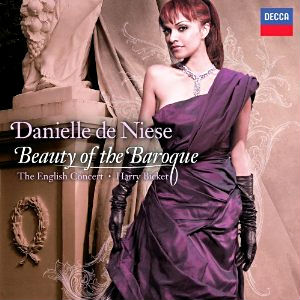
I could feel my face (to say nothing of my spirits) sink as I opened an envelope from La Cieca containing a new Decca CD
to review: “The Beauty of the Baroque” from Australian-American soprano Danielle de Niese with Harry Bicket conducting The English Concert. Why me?
Having endured rather than enjoyed her Cleopatra, Euridice, Despina and, most recently, Ariel in “The Enchanted Island,” I cursed the gods and shoved aside the CD in its super-deluxe press presentation folder until after the opening of the Met’s baroque fantasy on New Year’s Eve. Having found her hyperactive sprite the nadir of that uneven gala, I was shocked when I finally listened to the CD: it’s not terrible!
De Niese’s career began auspiciously in 1998 when she debuted at just nineteen (while still a student at Mannes School of Music) as Barbarina on opening night of the Mer’s current production of Mozart’s “Le Nozze di Figaro” in a starry cast that included Renée Fleming, Cecilia Bartoli and Bryn Terfel. Her big breaks came just a few years later as Cleopatra in Handel’s “Giulio Cesare,” first in Amsterdam, then Paris (both with Marc Minkowski conducting) and then, most importantly, replacing Rosemary Joshua for the premiere run of David McVicar‘s production conducted by William Christie at the Glyndebourne Festival, whose chairman she is now married to (which might account for the “Madonna at her most faux-British” accent that de Niese adopts on the CD’s accompanying promotional DVD).
The video of the McVicar production became her calling-card, but I must admit I’ve never viewed it–after hearing the BBC Proms broadcast, I decided I didn’t need to see a Cleopatra of such modest vocal accomplishment. All too predictably any discussion of this soprano focuses on her strikingly exotic good looks far more than on her musical gifts. The CD presentation (featuring many photos of de Niese in no fewer than six gowns) prominently displays a quote that might appear to be damning its artist with faint praise:
“That the gorgeous Danielle de Niese is a creature of the theater with a brain and a fascinating timbre is pretty clear by now. Anyone who has seen her live can only marvel at how comfortable she is moving, acting, pouting, dancing, singing, laughing, crying—indeed, interpreting.”
I’ve been struck in all her recent Met appearances not only by the unfocused, shrill vocal quality and fussy diction but by a stage persona more about playing to the audience than delineating a character or inter-acting with her fellow performers. Every moment screams: “Look at me! Love me! Aren’t I hot and/or adorable?” I wasn’t surprised when someone told me that one of de Niese’s nicknames is “La Muggissima”! However, apparently directors love “it” (or are at a loss to contain “it”) and many audiences do too as will probably be seen at the HD transmission of “The Enchanted Island.”
If one takes seriously Roger Pines’s annoyingly hagiographic program note, one pictures de Niese spending long months in dusty libraries digging out obscure 17th and 18th century gems for this CD; however, after an all-Handel, then an all-Mozart program, de Niese’s third solo disc is a disappointingly familiar baroque miscellany, with Dowland songs and two arias from Bach cantatas, in addition to the inevitable “Ombra mai fu” and “Dido’s Lament.”
Imagine then my surprise when I discovered that much of the CD is actually rather appealing. Clearly someone has stepped in and clamped down on the brassy, over-emphatic style that has marred so many of de Niese’s performances. Most of the music is slow and quiet and proves that–when not always shooting for the back row of the theater (or beyond)–the voice can be quite pleasant. Even a showpiece like “Let the bright seraphim” is done a more refined way than I had ever thought possible. Perhaps Harry Bicket’s low-key conducting had a salutary dampening effect—and all to the good. Intimate Handel arias from “Acis and Galatea” and the rare “The Triumph of Time and Truth” are quietly effective, much more so than the “Ombra mai fu” which suffers from startling unsteadiness. The most prominent flaw throughout is a chronic shortness of breath—ungainly gasps for air (so prominent in “The Enchanted Island”) afflict many of the pieces.
To add a bit of variety (in a decision surely made in her CD company’s boardroom) fellow Decca artist Andreas Scholl shows up for three duets, including the first movement of the Pergolesi “Stabat Mater” and the farewell duo from Handel’s “Rodelinda.” Scholl’s countertenor doesn’t seem the ideal match—although his pure, nuanced style might also have influenced de Niese to go for less showy effects than usual. She tries very hard to keep her vibrato in check in order to match her partner’s straight-tone, most effectively in “Pur ti miro” from Monteverdi’s “L’Incoronazione di Poppea.”
Of course there are many other more satisfying recordings out there illustrating “The Beuaty of the Baroque,” including Sandrine Piau’s two very beautiful Handel CDs on Naïve. (Piau, a much more accomplished singer, was rumored to have been bought out of her contract for a 2006 Glyndebourne revival of “Giulio Cesare” in favor of de Niese because McVicar couldn’t imagine anyone else embodying his razzle-dazzle vision of Cleopatra.) As the two Dowland lute songs are surprisingly the disc’s highlights, one wonders if de Niese might profitably consider a career as the next Emma Kirkby?
For those interested in seeing (and hearing) de Niese in more intimate surroundings than her usual Lincoln Center venue, Decca is presenting a CD release event at New York City’s Le Poisson Rouge (similar to the one held this fall for Joseph Calleja’s latest) on Monday January 23rd at 7:30PM.


























Comments